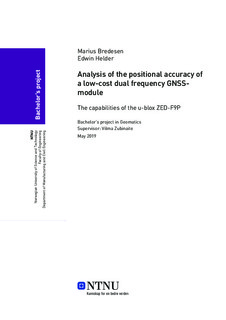| dc.contributor.advisor | Zubinaite, Vilma | |
| dc.contributor.author | Bredesen, Marius | |
| dc.contributor.author | Helder, Edwin | |
| dc.date.accessioned | 2019-09-06T14:01:06Z | |
| dc.date.available | 2019-09-06T14:01:06Z | |
| dc.date.issued | 2019 | |
| dc.identifier.uri | http://hdl.handle.net/11250/2613108 | |
| dc.description.abstract | Formålet med vår oppgave er å teste den nye GNSS-modulen, ZED-F9P utgitt av u-blox. For deretter å analysere målingene for å se hvilke bruksområder modulen er best egnet til. Målemetodene vi velger å bruke til analysen er forskjellige typer sanntidsmålinger, samt forskjellige typer fase-baserte statiske målinger. Sanntidsmålingene består av dynamiske og stasjonære målinger, samt hvilken nøyaktighet vi kan forvente av disse.
De statiske målingene består av måleperioder på 1,3,6 og 24 timer, logget på tre forskjellige søyler med forskjellige forutsetninger for satellitt dekning. Disse måleperiodene skal da sammenliknes for å se hvor høy nøyaktighet man kan oppnå med de forskjellige måle-tidene, samt at resultatene sammenliknes med tilsvarende målinger gjort av en Leica GS16 mottaker. De utjevnede koordinatene fra 24-timers målingene antas å være det resultatet som gir koordinater nærmest den absolutte posisjonen til søylene. Disse koordinatene utgjør da grunnlaget for vår analyse av målinger med u-blox-modulen.
Resultatene fra alle de statiske måleperiodene ble overaskende gode, u-blox målingene hadde noe større standardavvik, men klarte å holde følge med Leica. Alle målinger hadde en maksimal spredning på 1,27cm i S1, som var fra u-blox 1-times målingen, til u-blox 3-times målingen. Sanntidsmålingene med u-blox ga også forventet nøyaktighet på 1-3cm, men i ett par av målingene oppstod det systematiske feil som en følge av at antennen vår muligens ble påvirket av flerveisinterferens.
Man kan konkludere med at statiske målinger med etter-prosessering gir forventet nøyaktighet, og at forskjellene mellom F9P og GS16 ikke ligger i selve mottakeren. Men sanntidsmålingene viser at antennen vi kjøpte for 400 NOK, ikke er veldig resistent mot flerveisinterferens. En antenne av bedre kvalitet kan muligens gi mer konsise sanntidsmålinger. | |
| dc.description.abstract | The purpose of our thesis is to test the new GNSS module, ZED-F9P released by u-blox. In order to do this, we analyze the measurements to see which applications the module is best suited for. The measurement methods we choose to use for the analysis, are different types of real-time measurements, as well as different types of phase-based static measurements. The real-time measurements consist of dynamic and stationary (static) measurements, as well as the accuracy we can expect.
The static measurements consist of measuring periods of 1,3,6 and 24 hours, logged on three pillars with different surroundings. These measurement periods are later compared, in order to see how high accuracy that can be achieved with the different time intervals. Afterwards the results are compared with corresponding measurements made by a Leica GS16 receiver. The adjusted coordinates from the 24-hour measurements are considered as the coordinates closest to the absolute position of the pillars. These coordinates then form the basis for our analysis of u-blox module measurements.
The results from all the static measurement periods were surprisingly good, the u-blox measurements had somewhat larger standard deviation but managed to keep up with Leica. All measurements had a maximum difference of 1.27cm in S1, which was from the u-blox 1-hour measurement to the u-blox 3-hour measurement. Real-time measurements with u-blox also provided the expected accuracy of 1-3cm, but in two datasets, systematic errors occurred, as a result of our antenna being affected by multipath.
As a conclusion, static measurements with post-processing provide expected accuracy, and the differences between F9P and GS16 are not in the receiver itself. But the real-time measurements show that the antenna we bought for 400 NOK is not very resistant to multipath. On the other hand, a high-quality antenna may provide more consistent accuracy for real-time measurements. | |
| dc.language | eng | |
| dc.publisher | NTNU | |
| dc.title | Analysis of the positional accuracy of a low-cost dual frequency GNSS-module | |
| dc.type | Bachelor thesis | |
